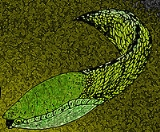
Arandaspis
Encyclopedia
Arandaspis prionotolepis is an extinct species of jawless fish
that lived in the Ordovician
period, about 480 to 470 million years ago. It is the oldest known vertebrate.
Its remains were found in Alice Springs, Australia
in 1959, but it was not discovered that they were the oldest known vertebrates until the late 1960s. Arandaspis is named after a local Aboriginal
tribe, the Aranda (currently called Arrernte
).
Arandaspis was about 15 cm (6 in) long, with a streamlined body covered in rows of knobbly armoured scute
s. The front of the body and the head were protected by hard plates with openings for the eyes, nostrils and gill
s. Although it had no jaws, Arandaspis might have had some moveable plates in its mouth, serving as lips, sucking in food particles. The low position of its mouth suggests Arandaspis foraged the ocean floor. It had no fins; its only method of propulsion was its horizontally flattened tail. As a result, it probably swam in a fashion similar to a modern tadpole
.
Agnatha
Agnatha is a superclass of jawless fish in the phylum Chordata, subphylum Vertebrata. The group excludes all vertebrates with jaws, known as gnathostomes....
that lived in the Ordovician
Ordovician
The Ordovician is a geologic period and system, the second of six of the Paleozoic Era, and covers the time between 488.3±1.7 to 443.7±1.5 million years ago . It follows the Cambrian Period and is followed by the Silurian Period...
period, about 480 to 470 million years ago. It is the oldest known vertebrate.
Its remains were found in Alice Springs, Australia
Australia
Australia , officially the Commonwealth of Australia, is a country in the Southern Hemisphere comprising the mainland of the Australian continent, the island of Tasmania, and numerous smaller islands in the Indian and Pacific Oceans. It is the world's sixth-largest country by total area...
in 1959, but it was not discovered that they were the oldest known vertebrates until the late 1960s. Arandaspis is named after a local Aboriginal
Indigenous Australians
Indigenous Australians are the original inhabitants of the Australian continent and nearby islands. The Aboriginal Indigenous Australians migrated from the Indian continent around 75,000 to 100,000 years ago....
tribe, the Aranda (currently called Arrernte
Arrernte people
The Arrernte people , known in English as the Aranda or Arunta, are those Indigenous Australians who are the original custodians of Arrernte lands in the central area of Australia around Mparntwe or Alice Springs in the Northern Territory. The Arrernte tribe has lived there for more than 20,000 years...
).
Arandaspis was about 15 cm (6 in) long, with a streamlined body covered in rows of knobbly armoured scute
Scute
A scute or scutum is a bony external plate or scale, as on the shell of a turtle, the skin of crocodilians, the feet of some birds or the anterior portion of the mesonotum in insects.-Properties:...
s. The front of the body and the head were protected by hard plates with openings for the eyes, nostrils and gill
Gill
A gill is a respiratory organ found in many aquatic organisms that extracts dissolved oxygen from water, afterward excreting carbon dioxide. The gills of some species such as hermit crabs have adapted to allow respiration on land provided they are kept moist...
s. Although it had no jaws, Arandaspis might have had some moveable plates in its mouth, serving as lips, sucking in food particles. The low position of its mouth suggests Arandaspis foraged the ocean floor. It had no fins; its only method of propulsion was its horizontally flattened tail. As a result, it probably swam in a fashion similar to a modern tadpole
Tadpole
A tadpole or polliwog is the wholly aquatic larval stage in the life cycle of an amphibian, particularly that of a frog or toad.- Appellation :...
.

